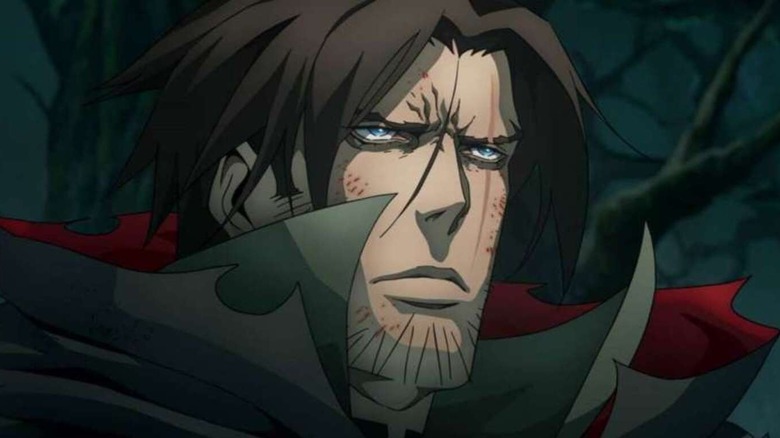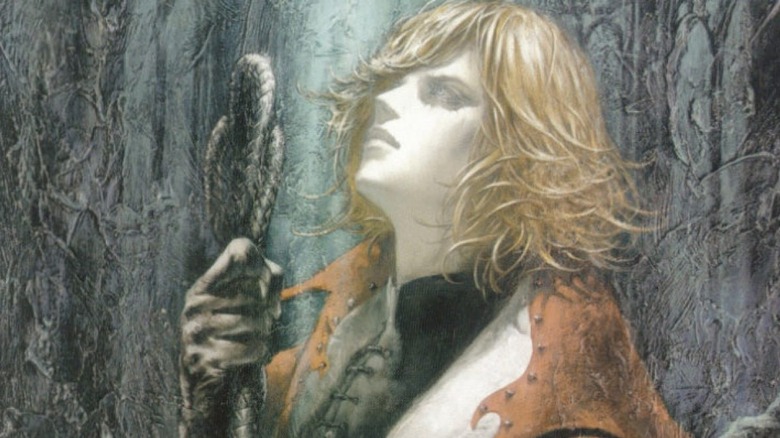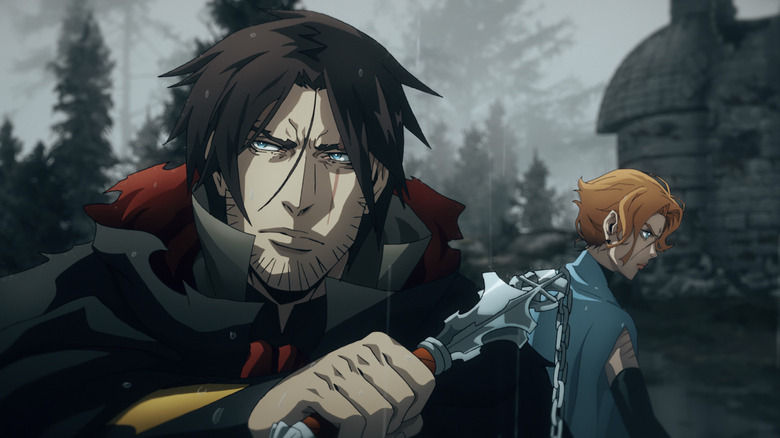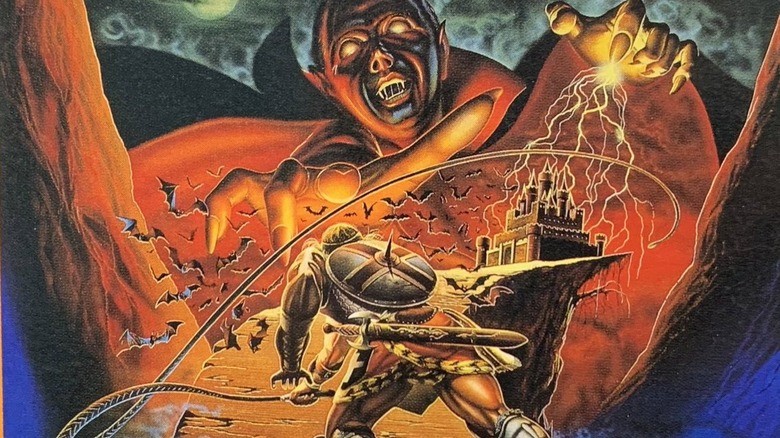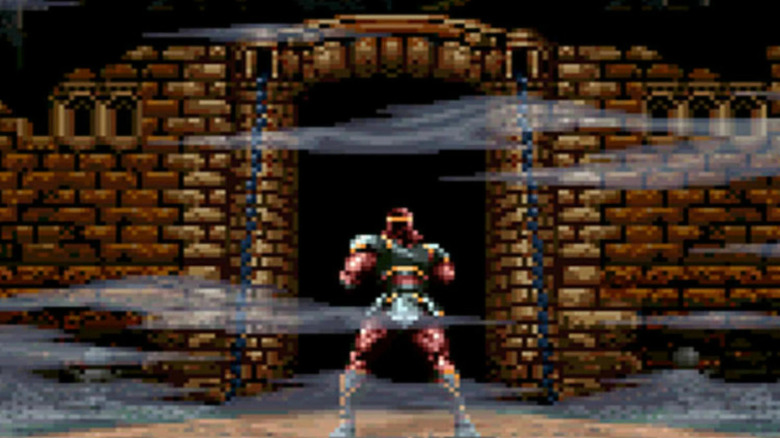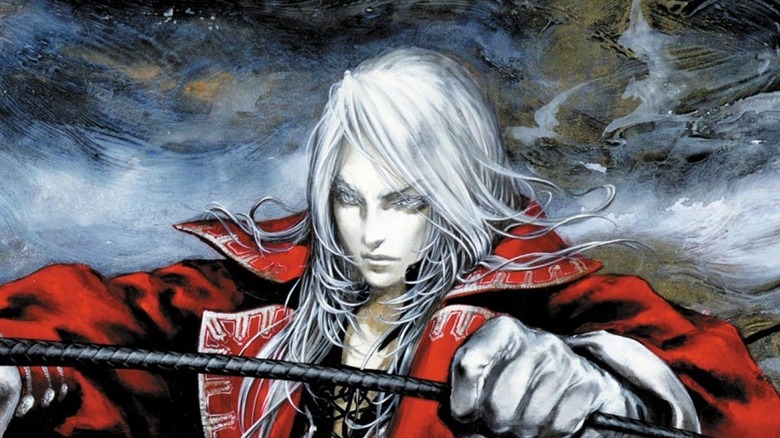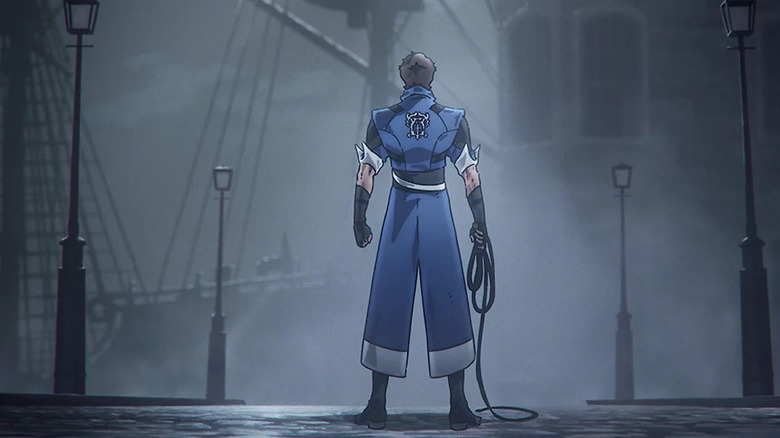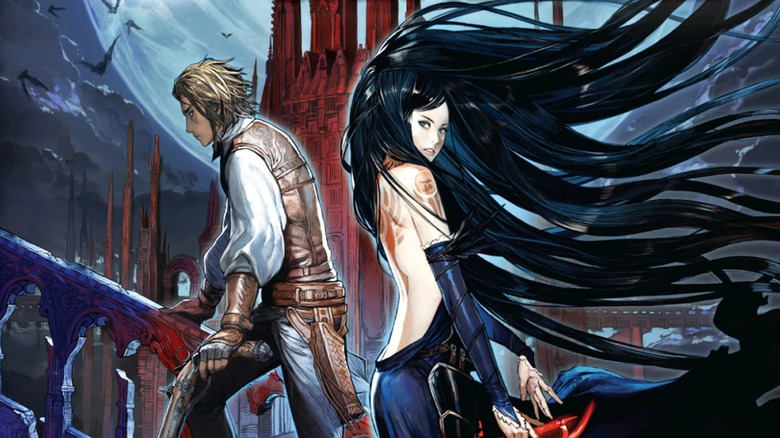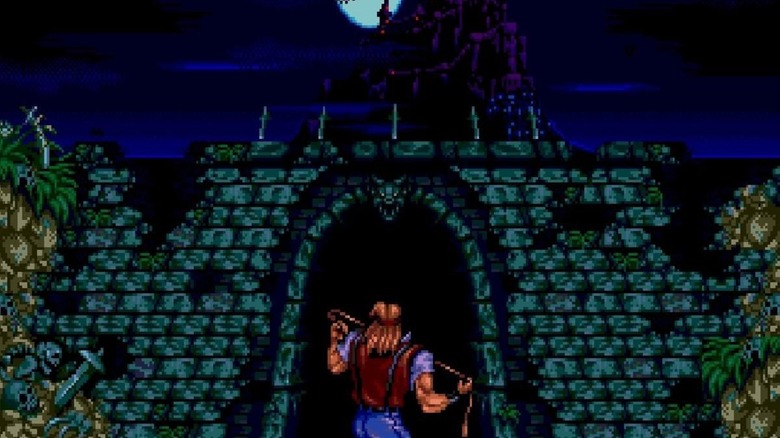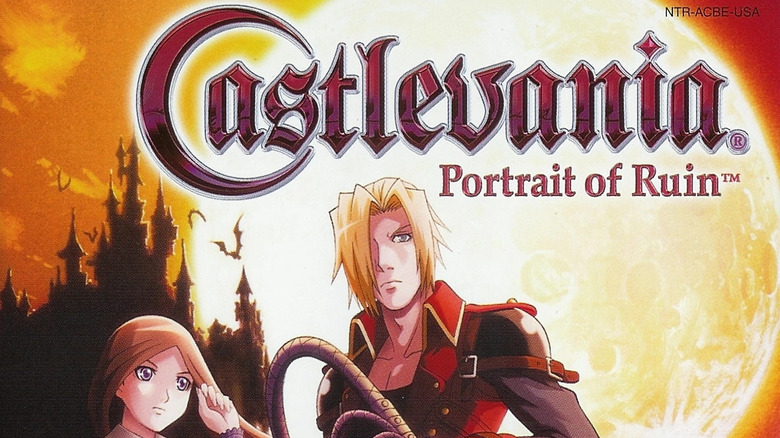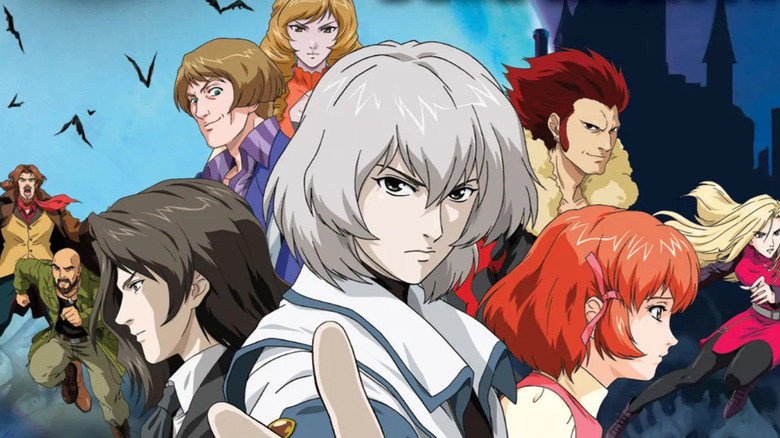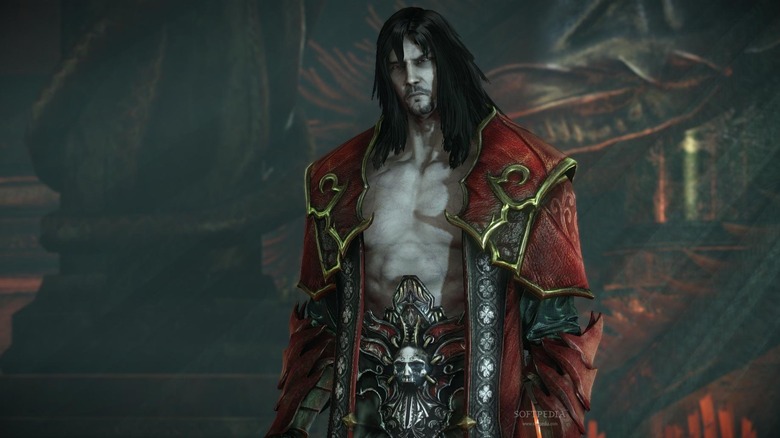Castlevania's Complete Timeline Explained
One of the most enduring video game franchises of all time is "Castlevania," which was launched by prolific game developer and publisher Konami in 1986. Since then, the series has expanded to appear in virtually every subsequent game console generation, while Netflix has adapted the franchise into a popular original animated series. Following the original series' conclusion in 2021, a spinoff series, "Castlevania: Nocturne," is poised to premiere on the streaming service, continuing the long-running feud between the vampire warlord Dracula and the vampire hunting Belmont Clan.
With a story that stretches from the Transylvanian region of Wallachia in the 11th century to the outskirts of Tokyo, Japan in the 21st century, there is an extensive history of violence that makes up the "Castlevania" officially recognized timeline. Here is the "Castlevania" timeline in full, from its origins amidst the Crusades to its final showdown with Dracula and the forces of darkness in the near future on the other side of world. Also examined is how the video game series' narrative chronology aligns with the story presented by its animated adaptation on Netflix, along with nods to the world of myths and monsters that has been thrilling gamers for decades, plus a brief exploration of some less-than-canonical games worth mentioning.
1094 - The Belmonts vampire hunting destiny begins
The story of "Castlevania" begins in the midst of the Crusades, with Leon Belmont abruptly returning to his home in Wallachia from the distant war in the Holy Land after learning his betrothed Sara is kidnapped by the vampire lord Walter. As Leon squares off against Walter, he forges the magical Vampire Killer whip with the doomed Sara's soul, with the weapon becoming passed down to Leon's descendants for centuries in their own battles against myths and monsters. By the end, Leon learns the whole confrontation was orchestrated by his jealous best friend Mathias Cronqvist so Mathias could use dark magic to gain immortality albeit at the cost of his own humanity.
Depicted in the 2003 PlayStation 2 video game "Castlevania: Lament of Innocence," Leon's adventures are the earliest in the franchise's official timeline and sets the Belmont Clan's vampire hunting legacy into motion. In addition to showcasing the creation of the Vampire Killer, Mathias eventually transforms into Dracula as the cost for his unholy immortality. "Castlevania" Season 2 contains a direct reference to "Lament of Innocence," with a portrait of Leon in his crusader gear appearing in Trevor Belmont's ancestral stronghold, resembling his appearance in "Lament of Innocence."
1476 - Dracula unleashes his armies upon Wallachia
Centuries after being transformed into a fearsome vampire and taking on a new name, Dracula weds a Lisa, a human, in 1455. Lisa reminds Dracula of his own humanity and capacity for love, and the two share a son named Alucard whom they raise together in Dracula's castle. In 1475, Lisa is captured by local villagers on behalf of the clergy and burned at the stake, since the Church sees their union as a sacrilegious act punishable by death. In retaliation, Dracula unleashes his monsters on Transylvania the following year, vowing to completely eradicate humanity in retribution for the Transylvanian clergy murdering his wife.
The 1989 video game "Castlevania III: Dracula's Curse" follows Trevor Belmont allying with the sorceress Sypha Belnades and Alucard to stop Dracula and his associates' rampage as Transylvania's last hope from the forces of darkness. The 2005 follow-up "Castlevania: Curse of Darkness" takes place in 1479, with one of Dracula's Devil Forgemasters, Hector, returning to Dracula's castle to stop his old friend Isaac from resurrecting the vampire. The original "Castlevania" Netflix series combines and streamlines elements of "Dracula's Curse" and "Curse of Darkness," depicting Trevor's battle against the vampires and Hector's rebellion against his monstrous masters with the fate of Wallachia hanging in the balance.
1576 - Dracula rises again to menace the Belmonts
In 1576, a full century after Trevor's showdown with Dracula, his and Sypha's descendant Christopher Belmont take up the Vampire Killer to fight a resurrected Dracula in Wallachia. 15 years later in 1591, Christopher's young son Soleil is kidnapped by Dracula in order to rebuild his evil kingdom with Soleil's fledgling magical powers, with Dracula using dark magic to transform the boy into a demon. In order to rescue his son, an older Christopher wields the Vampire Killer once again to defeat Dracula and restore Soleil from the demonic corruption induced by the undead warlord, preventing the resurgence of Dracula's sinister empire.
Christopher's first confrontation with Dracula is depicted in the 1989 Game Boy title "Castlevania: The Adventure," which marked the franchise's debut on a handheld console while expanding its shared history. Christopher's rematch with Dracula for the fate of his son takes place in the 1991 Game Boy direct sequel "Castlevania II: Belmont's Revenge," concluding Christopher's feud with the vampire. Christopher's exploits cover the Belmonts' activities in the 16th century, presumably as the first time Dracula resurfaced after being defeated by Trevor and his allies, with the vampire now targeting the Belmonts directly after recalling Trevor's role in his previous downfall.
1691 - Simon Belmont claims his vampire hunting destiny
The very first time period explored in the "Castlevania" franchise is in the year 1691, with vampire hunter Simon Belmont as the protagonist in the inaugural video game "Castlevania" for the Nintendo Entertainment System, released in 1986. Taking place a full century after the events of "Belmont's Revenge," Simon wielded the Vampire Killer whip to defeat Dracula after the vampire rose from the grave and launched renewed effort to conquer Transylvania. This initial showdown would be reimagined in 1991's "Super Castlevania IV" on the Super Nintendo and the 2001 PlayStation game "Castlevania Chronicles," updating Simon's classic battle with Dracula for new generations with more advanced hardware and completely redesigned levels and enemies.
Simon's adventures continued in the 1987 game "Castlevania II: Simon's Quest" for the NES, which served as a direct sequel to the original "Castlevania" game. Set in 1698, seven years after his first confrontation with Dracula, Simon discovers the vampire cursed him with his last breath, as his body steadily deteriorates since his fateful battle against the undead villain. Simon gathers Dracula's scattered body parts and resurrects the monster himself, destroying Dracula in a heated rematch. As such, he lifts the curse placed upon him to live the rest of his life in relative peace.
1748 - Juste Belmont honors his grandfather's legacy
50 years after the events of "Simon's Quest," unrest begins to threaten the stability of Wallachia once again. This time, Simon's grandson Juste Belmont steps up to carry on his family's warrior legacy. In the years since Simon saved Transylvania from Dracula on two separate occasions, his valiant exploits became more widely known and the Belmont Clan were recognized as heroes. Juste grew up facing this high level of expectation to live up to his legendary lineage, with the Belmonts revered throughout the region, leading his best friend Maxim Kischine to become deeply jealous of him.
Matters between Juste and Maxim came to a head in the 2002 Game Boy Advance title "Castlevania: Harmony of Dissonance," as Juste proved himself worthy of his heroic heritage. Juste and Maxim's mutual friend Lydie Erlanger was kidnapped by shadowy forces and held captive in Dracula's castle while Maxim began to act strangely after attempting to destroy Dracula's remains alone. It is revealed that Death possessed Maxim through his latent jealousy towards Juste in an attempt to resurrect Dracula, with Maxim kidnapping Lydie on Death's behalf to begin the unholy ritual. Upon learning this, Juste defeats Death and Dracula while restoring Maxim to his senses as he rescues Lydie from the undead villains.
1792 - Richter Belmont gains allies in the fight against Dracula
In 1792, 44 years after the events of "Harmony of Dissonance," Richter Belmont answers the call to arms when Dracula is resurrected by a black mass and launches a renewed bid to conquer Transylvania. In Dracula's opening attack, his forces kidnap four young women from a nearby town, including Richter's love Annette and Annette's friend Maria Renard, with Maria revealing her own vampire hunting abilities after being rescued. These events are depicted in the 1993 TurboGrafx-16 game "Castlevania: Rondo of Blood," its 1995 Super Nintendo port "Castlevania: Dracula X," and its 2007 enhanced remake "Castlevania: The Dracula X Chronicles" on the PlayStation Portable.
Then in 1797, five years after "Rondo of Blood," Richter disappears while investigating Dracula's castle when it unexpectedly reappears back in Transylvania during the 1997 PlayStation game "Castlevania: Symphony of the Night." Alucard awakens from his slumber and teams up with Maria to venture inside the castle and learn what is happening, rescuing Richter and defeating Dracula once again. Richter and Maria are slated to star in the upcoming animated show "Castlevania: Nocturne," retaining the games' late 18th century setting and continuing the Belmont saga centuries after the events of the original animated "Castlevania" series.
19th century - Shanoa fills the void left by the Belmonts
Sometime in the 19th century, the Belmont Clan mysteriously disappeared after Richter's adventures in "Symphony of the Night," with powerful organizations founded throughout Europe to prepare for Dracula's eventual return. In an unspecified year during the 19th century, a young woman named Shanoa, who wields supernatural powers on behalf of the Order of Ecclesia, is trained to master its magical glyphs. After the Order's glyphs are stolen by a man named Albus, Shanoa sets out to recover them from him, learn more about the organizations in the region, and discover what exactly became of the Belmonts.
Recounted in the 2008 Nintendo DS game "Castlevania: Order of Ecclesia," Shanoa learns that Albus kidnapped and experimented on the Belmont Clan to help him control the glyphs against Dracula without the magical devices killing him. After rescuing the Belmonts from imprisonment and further experimentation, Shanoa learns the Order intended to sacrifice her with the glyphs to resurrect Dracula, leading her to rebel against them and her old master Barlowe. Defeating both Barlowe and the reborn Dracula, Shanoa is saved by Albus, who heroically gives up his own life to allow Shanoa survive using the glyphs, restoring peace to Europe and ensuring the Belmont Clan lives on.
1897 - Bram Stoker's literary classic connects to Castlevania
In an interesting twist, the 1994 Sega Genesis/MegaDrive game "Castlevania: Bloodlines" reveals that the events of Bram Stoker's classic novel "Dracula" are canonical to the official "Castlevania" timeline. In 1897, a group of adventurers, including the American Quincy Morris, pursue Dracula to Transylvania from London and destroy the vampire, at the expense of Quincy's life in the bloody battle. In a retcon from Stoker's original story, Quincy's young son John Morris is present to witness his father's death, as is John's best friend Eric Lecarde, with the Morris family described as being distantly related to the Belmonts.
"Bloodlines" takes place 20 years later, during the height of World War I in 1917. The evil vampire Elizabeth Bartley is responsible for orchestrating the conflict to provide the blood and chaos for an unholy ritual to resurrect Dracula. Now adult vampire hunters themselves, John and Eric battle Bartley's forces across a war-torn Europe, from the ruins of Dracula's castle in Transylvania to Bartley's hideout in England. While Bartley is able to resurrect Dracula with Death's help before both are defeated by John and Eric, the two men manage to send Dracula back to the grave moments after his revival in a fierce showdown.
1944 - World War II causes chaos for the Castlevania Universe
Just as "Bloodlines" was set at the catastrophic height of World War I, its 2006 direct sequel "Castlevania: Portrait of Ruin" on the Nintendo DS was set amidst the carnage of World War II in 1944. Following John Morris' son Jonathan, who inherited the Vampire Killer whip from his late father, and the young sorceress Charlotte Aulin, the two heroes ventured together inside Dracula's castle to confront the vampiric artist Brauner. Brauner is harnessing the bloodshed and destructive chaos from the global conflict, using it to reconstruct the castle and imbue his artwork with unholy energy. Through this fueled dark magic, Brauner's paintings opened portals to pocket dimensions to siphon their raw power in his attempt to eradicate humanity, delaying Dracula's resurrection to lead this obsessive quest himself.
Working closely together, Jonathan and Charlotte rescue and restore Eric Lecarde's daughters Stella and Loretta, who were both transformed into vampires by Brauner when they attempted to avenge their father's death at the artist's undead hands. Following Brauner's defeat and upending of his plans, Dracula's resurrection proceeds without his interference but the vampire warlord is quickly vanquished by Jonathan and Charlotte. With peace restored to Transylvania, the four vampire hunters leave the ruins of Dracula's castle while Eric's spirit is able to rest in peace with the restoration of his daughters.
1999 - Julius Belmont starts a new era for Dracula's life
In 1999, Julius Belmont has his own fateful confrontation with Dracula and slays the vampire, seemingly for good, to conclude his family's ancient feud. 36 years later in 2035, Dracula's castle mysteriously reappears on the outskirts of Tokyo, with transfer high school student Soma Cruz and his friend Mina Hakuba magically drawn to it during a solar eclipse. Meeting with Julius, Alucard, and the young witch Yoko Belnades, the group learns that Soma is the reincarnation of Dracula, with his dark heritage threatening to consume him and result in Dracula's full resurrection.
Soma and his adventures are introduced in the 2003 Game Boy Advance title "Castlevania: Aria of Sorrow," with Soma rejecting his unholy birthright and determined to use his supernatural powers for good. Soma's story continues in the 2005 direct sequel "Castlevania: Dawn of Sorrow" for the Nintendo DS, with the game's events taking place a year later in 2036. Though Soma was able to resist becoming the new Dracula, he is targeted by a cult who intend to sacrifice him and resurrect the vampire within him. With the cult also targeting Soma's friends, the hero reunites with his old allies to confront them in a replica of Dracula's castle where they are based.
Non-canonical events in the Castlevania timeline
Not every "Castlevania" game takes place within the official timeline recognized by Konami, with several installments quietly being removed from continuity sometime after their respective release. The 1997 Game Boy title "Castlevania Legends" was intended to provide the origin of the Belmonts' feud against Dracula, with Sonia Belmont confronting the vampire during his first rampage, before being rendered non-canonical by "Lament of Innocence." Similarly, the two "Castlevania" games released for the Nintendo 64, along with 2001's "Castlevania: Circle of the Moon" on the Game Boy Advance, were removed from continuity by longtime franchise producer Koji Igarashi. According to 1up.com, Igarashi explained this move was done as they were considered side-stories that clashed with the canon established by the main installments in the video game series.
In 2010, the franchise saw a divergent reboot timeline that began with "Castlevania: Lords of Shadow," depicting an alternate origin for Dracula and the Belmont Clan. In this reboot timeline, Gabriel Belmont transformed into a vampire and took on the name Dracula after failing to rescue his late wife Marie in the year 1047. Dracula's war against his descendants, who maintained their Belmont name, was explored in the 2013 sequel "Castlevania: Lords of Shadow — Mirror of Fate" and concluding with "Castlevania: Lords of Shadow 2." The latter game saw Dracula team up with his vampiric son Alucard in present-day to defeat Satan and prevent him from unleashing Hell on Earth while meeting Victor, the last of the Belmont lineage.

